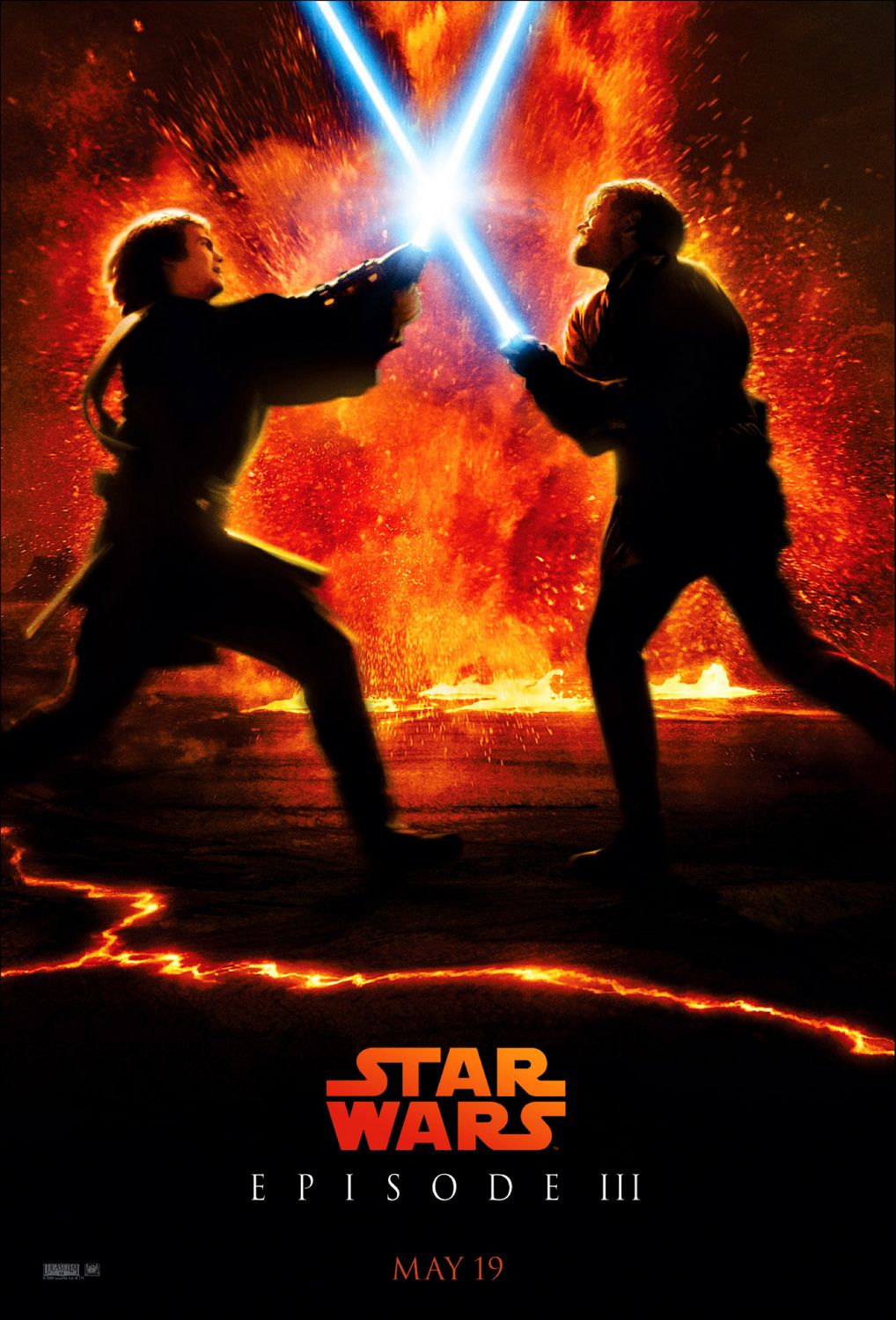
04 May Star Wars Episode III: Revenge of the Sith
STAR WARS EPISODE III: REVENGE OF THE SITH
dir. George Lucas, starring Hayden Christensen, Ewan McGregor, Ian McDiarmid, and Natalie Portman
Star Wars Episode III: Revenge of the Sith, the closing chapter of act 1 of the Star Wars saga, weaves together a number of threads dangled by its predecessors to deliver a satisfying conclusion of a trilogy of movies fraught with inconsistent filmmaking. With this final entry into the trilogy, it’s easier to step back and appreciate the full scope of the story George Lucas created to tell about the rise and fall of Anakin Skywalker. In this final act of the prequels, Anakin’s fall to the dark side is complete, Obi-Wan Kenobi becomes the stuff legends are made of, and George Lucas manages a shred of redemption.
The movie starts out with a jolt of action as Anakin and Obi-Wan defeat Count Dooku, rescue Chancellor Palpatine, and deliver him safely back to Coruscant. Once there, Padme drops the bombshell on Anakin fans were waiting for: she’s pregnant. Their secret tryst has continued since the ending moments of Episode II, and while that relationship takes a backseat to other events in the film, it is still a large contributing factor of what was to come. Meanwhile, the war with the Separatists ignited off screen between Episodes I and II is nearing an end with Obi-Wan at the lead, taking the fight to General Grevious on one front with Yoda on Kashyyyk on another. Meanwhile, Chancellor Palpatine’s slow twisting of the knife that leads to Anakin’s break from the Jedi Order is his greatest masterstroke, as Anakin turns his back on his brethren, ruthlessly slaughters a bunch of kids (remember that, when you’re taking about his ‘redemption’ in Return of the Jedi), and finally lays it out with his former master. The end result is the story of mistrust, manipulation, and, ultimately, tragedy.
Returning to the role that would catapult him into stardom and eventually negatively overshadow his entire body of work, Hayden Christensen handles Anakin’s inner turmoil with a surprising amount of skill. After spending the entirety of Attack of the Clones as whiny, unappreciative teen, Christensen is allowed to actually act in this film, giving the characters a bit of nuance and layers. While some of his dialogue and performance is still stiff, some of that is due in part to the clunky dialogue, especially in his few scenes with Padme. This is a result of Lucas’ inability to write meaningful dialogue between two characters who love each other. Man just doesn’t have it in him. Due to this, Christensen’s performance suffers, but not enough to be distracting.
Ewan McGregor was born to play Obi-Wan Kenobi. Continuing his tradition of knocking the assignment out of the ballpark, McGregor is equal parts warm, cheeky, and somber. McGregor’s interactions with Christensen come across as more natural when compared to the previous movie. Delivering a fine performance, and also carrying the film’s most memorable short monologue as Obi-Wan preaches to a burning, defeated Anakin, McGregor imbues the scene with the despair of two old friends turned tragic enemies. Obi-Wan’s leadership skills also come to the fore when dealing with the clone troopers and, thanks largely in part to McGregor’s performance, it’s easy to see why Obi-Wan is considered one of Star Wars’ most beloved characters.
The greatest sin of Revenge of the Sith is the erasure of Natalie Portman. A key central figure to both the Phantom Menace and Attack of the Clones, Padme’s role in Revenge of the Sith is reduced to worrisome wife. As the focus of the series shifted from Obi-Wan’s relationship with Qui-Gon to Obi-Wan’s relationship with Anakin to Anakin’s relationship with Palpatine, Padme mostly takes the backseat in this film. While the central motivation for Anakin’s actions, she’s used more of an excuse for Anakin to fall to the dark side than used as an actual character. This is a major failing of the film as it’s noted in the novelized adaptation that Padme is instrumental in the early formation of the rebellion that’s in full swing come Episode IV. However, Portman still manages to put her limited screen time to good use as she remains Anakin’s increasingly tenuous link to the light side of the Force.
Part of the reason for Portman’s lack of presence in the film? Ian McDiarmid as Chancellor Palpatine. Finally, fully realized and ready to break out of his shell, McDiarmid cuts loose in this film, chewing scenery and having a blast as the series’ overarching villain. McDiarmid, it seems, is just as ready to unleash his abilities as Palpatine himself was ready to come out from the shadows. The result is an absolute chaotic performance of the best kind from McDiarmid, operating like a kettle simmering just below the boiling point, waiting to explode. His speech at the Senate after his confrontation with Mace Windu remains especially chilling, with Lucas giving a finely veiled commentary on post 2001 American politics with the Senate happily giving up their freedoms for Palpatine’s “safe and secure society.”
George Lucas returns to write and direct the final installment of the prequel trilogy. Understanding the need for an epic and impactful ending, Revenge of the Sith is Lucas’ best work in both departments. Here, Anakin is conflicted, torn between his admiration of Chancellor Palpatine, his loyalty to the Jedi, and his love for Padme. Lucas massages these conflicting emotions to maximize the confusion in Anakin and manages to coax out a nuanced performance from Christensen. Edited by Roger Bartonand Ben Burtt, the movie opens with a thrilling action scene and proceeds to suffer during the second act as audiences wait for the inevitable. The film has high highs and low lows; the maneuvering of Anakin by both Palpatine and the Jedi Council can be slow at times but is still crucial to the overall storytelling. The cheap editing of Anakin and Obi-Wan’s final confrontation cannot be ignored; splicing together multiple angles of the same actions over and over in an effort to stretch out the length of the fight scene is a cheap tactic that once noticed is hard to ignore. However, the fantastical stunts and super agility of the Jedi is, by 2005 technological standards, worthy of praise. In this film, Lucas’ slavish devotion to advancements in CGI aren’t as glaringly obvious, perhaps due to the criticisms of Attack of the Clones. This is the most real and lived-in movie of the three, which lends to why it’s the superior film. John Williams once again shows up to remind us that he’s the world’s greatest living film composer, tying in motifs and themes of not just the prequel trilogy, but also a number of recognizable audio cues from the original trilogy as well. Without the efforts of John Williams, the Star Wars saga would still be an entertaining one, but it wouldn’t be STAR WARS.
Overall, Revenge of the Sith is far and away the strongest of the prequel trilogy. George Lucas’ foray into darker, more mature territory is a stark contrast to the light, pulpy tone of The Phantom Menace. Delivering a climax that’s been building for decades, Lucas and his team pay off years of fanatical desire to see the moment that changed the galaxy forever. Hayden Christensen comes ready to play in a performance far improved from the film’s predecessor, and Ewan McGregor again proves that he’s the superior Obi-Wan. Clocking in at (what was at the time) a staggering 2 hours and 20 minutes, some would think there’s definitely some film that could be whittled down, but owing to the immense scope, the run time is deserved. Outstanding action scenes, interspersed with passable bits of character development, closes the story on a note high enough to almost appreciate the trilogy as a whole. Almost.
Review by Darryl Mansel


No Comments